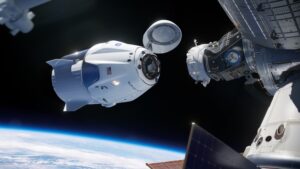NASA selects astronauts for Crew Dragon mission

WASHINGTON — NASA has completed the crew for the first operational SpaceX commercial crew mission to the International Space Station, one that will not include any Russian cosmonauts after Roscosmos officials said they would not fly on what they consider an unproven vehicle.
NASA announced March 31 that it had assigned veteran astronaut Shannon Walker to the Crew-1 mission of SpaceX’s Crew Dragon, along with Japanese astronaut Soichi Noguchi. They will join NASA astronauts Mike Hopkins and Vic Glover, who were assigned to the mission in 2018.
When Hopkins and Glover were assigned to the flight, NASA said that the other two seats on the spacecraft would be filled by NASA’s international partners. That includes not just NASA’s partners on what’s known as the U.S. Operational Segment of the station — Canada, Europe and Japan — but also Russia.
NASA officials said in recent months that, even after SpaceX and Boeing’s commercial crew vehicles, known in agency parlance as U.S. Crew Vehicles or USCV, entered service, they still planned to fly American astronauts on Soyuz spacecraft in exchange for flying Russian cosmonauts on commercial crew vehicles, a concept known as “mixed crews.” That would ensure that, if there was a problem with either a Soyuz or commercial crew spacecraft, there would be at least one American and one Russian on the station.
“Discussions are still underway to swap crew members on future USCV and Soyuz flights,” said former astronaut Tom Stafford during a March 30 teleconference of NASA’s International Space Station Advisory Committee, which he chairs. “This exchange would ensure ISS operations in the event of an anomaly on the crew vehicle or an anomaly that would require the crew vehicle to return to the Earth ahead of schedule.”
Stafford said that Russian officials, who met with Stafford’s committee in Houston in December, were reticent to fly cosmonauts on what to them are unproven vehicles. “The Russian side noted that, prior to agreeing to the mixed crew plan, there needs to be successful USCV launches,” he said. “Roscosmos will consider participation after successful launches, but will not participate in the first launch of the vehicle.”
The first operational commercial crew mission will not be the first launch of the Crew Dragon. That vehicle flew a successful uncrewed test flight, Demo-1, in March 2019. It will fly a crewed test flight, Demo-2, as soon as the latter half of May with NASA astronauts Bob Behnken and Doug Hurley on board.
The schedule for Demo-2 is holding for now despite an ongoing investigation into a premature engine shutdown on the most recent Falcon 9 launch March 18 as well as the loss of a Crew Dragon test article March 24 when a planned parachute test was aborted. NASA reaffirmed that schedule in a separate statement March 31 about the completion of a series of simulations of the Demo-2 mission involving Behnken and Hurley.
Stafford said that Roscosmos officials at that December meeting had concerns about development of the commercial crew vehicles. “The Russian side raised several questions related to the relatively compressed timeline for normal parachute deployment, noting that the Soyuz deploys parachutes at a much higher altitude,” he said after discussing parachute testing by SpaceX. The updated Mark 3 parachute design, NASA noted in a March 26 statement, had completed 24 tests to date, and was near the end of its test program.
There were also issues with the parachutes on Boeing’s CST-100 Starliner, which at the time of the joint meeting in December had recently performed a pad abort test where only two of three parachutes had deployed. In an uncrewed orbital flight later that month, Starliner’s parachute system worked normally despite problems with other aspects of the flight.
from SpaceNews.com https://ift.tt/2ypzUBw
Comments
Post a Comment